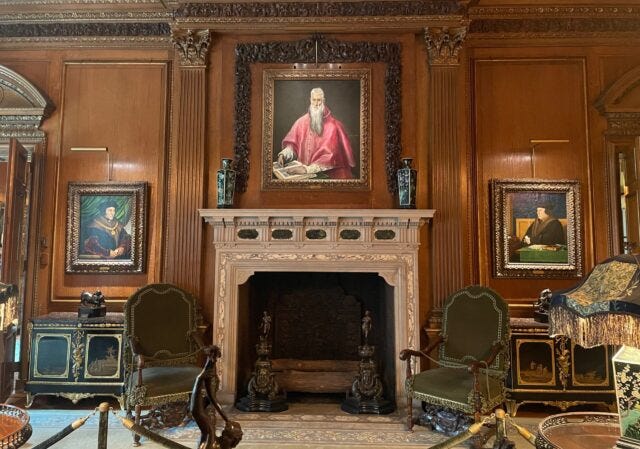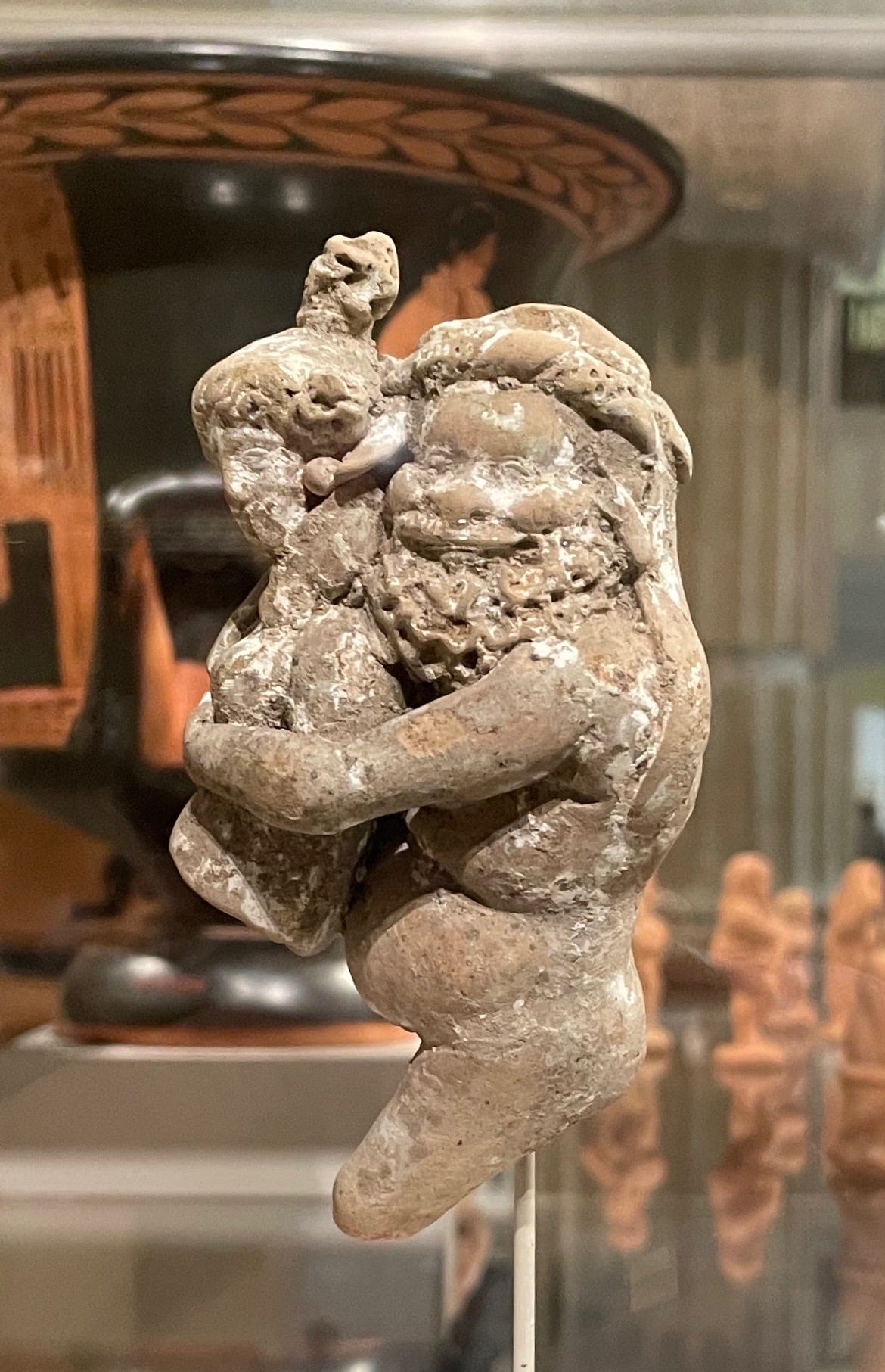Patrick Bringley shares his poignant story as a Met guard in All the Beauty in the World (photo by Joan Marcus)
“Where are we at this moment? It seems to me we’re in a place in this big city where space has been set aside for quiet and delicate things to happen. A sacred place in this sense: sacred just means set apart, set apart from the streets out there with their noise and its hurry and its giddy-up and its nonsense,” Patrick Bringley says in his one-man show, All the Beauty in the World. “In here, in this moment, we’re not building toward a future, we’re not worried about the past, we only have the present, the vital present, the now . . . and now . . . and right now.”
Bringley is talking about theater as much as the Metropolitan Museum of Art, where he spent ten years as a guard. He adds, “Some people, they can’t get over it, they look out at the world and they write poems and sing songs and paint pictures and they do all the things to fill up a two million square foot temple on Fifth Avenue. And others of us, we’re just a spellbound audience.”
Extended at the DR2 Theatre through May 25, the play was adapted by Bringley from his 2023 memoir, All the Beauty in the World: The Metropolitan Museum of Art and Me, in which he details how the tragic loss of his brother, Tom, led him to quit his job at the New Yorker, where he worked in the planning office for the magazine’s annual festival, and instead become a guard at the Met, where he gained new insights into life and art, learning from such colleagues as Joseph Akakpousa and Aada, who trained him. For ninety spellbinding minutes, Bringley shares the various positions guards use to stand for eight-to-ten-to-twelve-hour shifts, relates the vast range of skills and knowledge the guards have — “they could go out and rebuild the world,” he notes — and places specific paintings, sculptures, and other objects in a deeply personal context.
Discussing Titian’s Portrait of a Man (ca. 1515 ), he says, “I can’t believe it’s a single moment in time; there aren’t snapshots in this wing. Time seems to pool here instead of freeze, like there is no arrow of time, just this present, this vital present, a picture as whole, bright and unfading, as we would wish this young man’s soul to be.” He then talks about the envelope of photographs of Tom that he keeps in his Met locker: “Those are snapshots. They’re all mixed up, some are dogeared, others I’ve lost, they are captured moments in time; they are memories. But you know how all those memories in the plural, they add up to that one single memory of a loved one, that presence, that face you see when you close your eyes. It sure seems like that’s what Titian painted. And I suppose I took this job because here I don’t even need to close my eyes.”
Bringley, who is warm and friendly onstage, his mood even-keeled, moves slowly around director Dominic Dromgoole’s spare set, which consists of several benches and framed monitors where Austin Switser projects images of the works Bringley explores, from Tintoretto’s Doge Alvise Mocenigo Presented to the Redeemer (1577), the Athena Medici (ca. 138–92), Pieter Bruegel the Elder’s The Harvesters (1565), and Benvenuto di Giovanni’s Madonna and Child (ca. 1470) to Albrecht Dürer’s Salvator Mundi (ca. 1505), Vincent van Gogh’s Self Portrait with a Straw Hat (1887), the Simonetti Five Medallion Carpet (ca. 1500), the Met’s five Vermeers (ca. 1656–72), and the fragmented terracotta statuette of a satyr and maenad (third century BCE), among others. He also visits the seventeenth-century-style Astor Chinese Garden Court, where it says above the Moon Gate: “in search of quietude.”
The Frick reopened on April 17, offering quietude and more (photo by twi-ny/mdr)
The day after I saw All the Beauty in the World, I went to the Frick, which I refer to as my happy place. The museum reopened to the public on April 17 following a five-year renovation and expansion; for me it was like an afternoon with old friends, including John Constable’s Salisbury Cathedral from the Bishop’s Grounds, Goya’s The Forge next to Velázquez’s King Philip IV of Spain, Hans Memling’s Portrait of a Man, and the eternal triumvirate of Hans Holbein the Younger’s portraits of Thomas Cromwell and Sir Thomas More flanking El Greco’s St. Jerome. I also took a break in the Garden Court, where I found quietude. I didn’t use the map, preferring to locate my favorites on my own.
Over the next ten days, I went to the Met twice, to see Jennie C. Jones’s lovely Ensemble installation on the roof, a trio of abstract musical instruments that interact with the wind and the surrounding buildings, and the wonderful “Sargent & Paris” exhibit, which, in honor of the centennial of John Singer Sargent’s death, examines the American expat painter’s remarkably fruitful ten-year period in France, beginning when he was eighteen in 1874, featuring approximately one hundred pieces and culminating with a room dedicated to his most famous canvas, the scandalous Madame X (Virginie Amélie Avegno Gautreau).
On the first trip, I decided to track down as many of the works mentioned in Bringley’s play as I could, switching between the Met app and a PDF of the script, along with the assistance of the guards. Unfortunately, my phone died, so I only saw a few of them. When I returned the next week, I made sure the phone was fully charged, and I compiled a list of what object was in which gallery. Even with that information, I had to consult guards regularly, as the Met can be a bit of a maze; I told them what I was doing, and they were excited to help. We spoke about Bringley and the book, about standing for most of the day, about dealing with odd questions, and about the guards’ diversity in their backgrounds. I found every item that is currently on view, attempting to see them as Bringley did.
Fragmented, Terracotta statuette of a satyr and maenad, Greek, Tarentine, third century BCE (photo by twi-ny/mdr)
“The mornings are church mouse quiet. I arrive on my post about a half hour before the museum opens and there is nothing to bring my thoughts down to earth,” he says early in the play. “It’s just me and the Rembrandts. Just me and the Botticellis. Just me and these vibrant phantoms that are also . . . my companions, hanging around all day, same as me.”
As crowded as the Met can get, there is so much to see that you invariably discover yourself alone with masterpieces, just you and the Vermeers, you and the van Goghs, you and the Rembrandts; it can be as thrilling as it is humbling.
Jacopo Tintoretto (Jacopo Robusti), Doge Alvise Mocenigo Presented to the Redeemer, oil on canvas, probably 1577 (photo by twi-ny/mdr)
Delving into how guards stand, stretch, shake, lean, and pace, Bringley explains, “And it’s always watching. Another thing Aada taught me: ‘When you get bored of watching the people, you watch the art. When you get bored of the art, it’s back to the people.’ And there’s wisdom in that, but after two thousand days of this, I can’t say I get bored, not in the way you might think, and I think that’s because time works differently when you have heaps of it. If you have forty-five minutes to kill, that can feel agonizing. But if you have twelve hours to kill . . . You can’t kill it. You have to make peace with it. A museum guard’s hours can’t be frittered away, they can’t be killed, they can hardly even be spent. They’re going to be capacious, they’re going to feel exactly one hour long. And on a good day, that’s a good thing, because look where I am.”
Those words ring true whether you’re in a museum, at the theater, or just walking around this capacious city, making the most of your time, valuing every minute, every hour of where you are.
[You can follow Mark Rifkin and This Week in New York every day here.]








Coincidentally, I just gave my mother the book - I didn't know it had been made into a play! Thank you for doing this review!